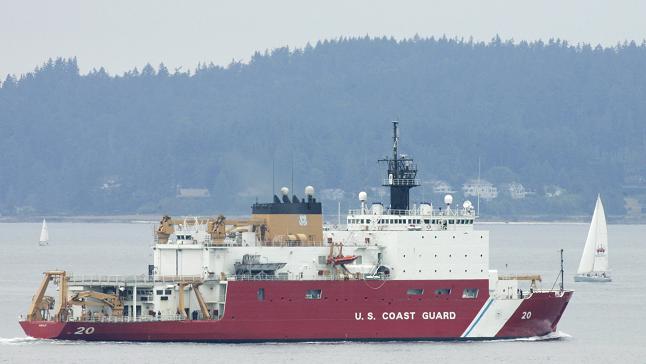U.S. officials consider leasing icebreakers as budget reality sinks in

WASHINGTON — Congress isn’t going to write a billion-dollar check, or several, to fund Arctic icebreakers anytime soon, so the Arctic’s advocates in Washington, D.C., are starting to look elsewhere.
There are “two very different needs for icebreakers in the Arctic,” Sen. Lisa Murkowski said at an Arctic symposium in Washington this week: commercial maritime activity, and search-and-rescue functions provided by the U.S. Coast Guard.
“And given the relatively fast pace in which the former is growing, I think it is worth the discussion to see if we should focus on the nongovernmental side of icebreaker activity first,” Murkowski said, suggesting public-private partnerships to pay for new icebreakers.
Bill to be introduced
Rep. Don Young plans to introduce a new bill next week to allow a public-private partnership to pay for a Coast Guard icebreaker. The bill, which Young will introduce with Rep. Duncan Hunter, R-Calif., would set up an account jointly funded by the Coast Guard, Navy and other federal sources that would either renovate, lease or charter a new Arctic icebreaker.
The cost of an icebreaker would take up the Coast Guard’s entire budget for shipbuilding activities, said John Farrell, executive director of the U.S. Arctic Research Commission. “It’s just too much. It can’t fit in the Coast Guard’s budget. It’s got to go in [the Defense Department],” he said.
Service life
Icebreakers tend to have a 40-year service life, said Adm. Paul Zukunft, Coast Guard commandant. Given that, Zukunft was skeptical of the idea of leasing icebreakers, he said at the symposium on Tuesday.
From a Coast Guard budgeting perspective, a multiyear lease wouldn’t save any money because payments for the entire lease would have to be set aside in the first year’s budget, Zukunft said.
“We could change that. That’s Congress’s fault,” Young said. “They charge the Coast Guard for the full amount of money, one time, when they lease it.”
“Every time we talk about building a ship, the Coast Guard wants to own the ship,” Young said. But leasing is a better option, and at two-thirds the price, he argued.
“You own a boat, you find out how much money you lose on it,” Young said.
“I funded the Polar Star and all the rest of those … icebreakers 38 years ago. And now they’re wore out. And one of the reasons they’re wore out is because we have a stupid rule in the Congress — we have to buy the cheapest part … to repair the ship. So all the ships are made up of little bastard parts. The hull is great, but it don’t operate,” Young said.
He wants the rule changed: best, not cheapest, parts for upgrades, and leases for new ships, with the owners handling maintenance.
U.S. behind other Arctic nations
Advocates for U.S. attention in the Arctic, particularly for military purposes, largely agree the country is well behind other Arctic nations when it comes to ports, vessels, funding and manpower.
Getting more funding is going to be a struggle as long as the Arctic is not viewed as a national priority, Murkowski said.
The snow-globe perception of the Arctic can be difficult to combat, said Farrell.
“More open water in the Arctic means more maritime traffic — there’s no secret there,” Murkowski said in a speech at the symposium Tuesday. “The Navy believes that between 2012 and 2025, vessel activity in the Bering Strait will more than double,” and vessels in the northern sea route will grow 10-fold, she said.
“The billion-dollar question here, though, is whether the United States is going to have the infrastructure in place to support that level of activity or whether we effectively cede operational control” to other countries, Murkowski said. “Make no mistake about it — an increase in Arctic activity is going to happen with or without the United States involved.”
In terms of Arctic capabilities, “right now we’re in very much of a stern chase,” Zukunft said. His focus is on managing that risk.
Public-private partnerships
Retired Coast Guard Adm. Robert Papp Jr., the special Arctic representative at the State Department, offered some perspective, noting that on any given day the Navy has two aircraft carriers at sea. But it owns at least 10.
“We have to keep one icebreaker” in operation, “and we have one icebreaker,” Papp said.
Icebreakers cost a fraction of what it costs to build an aircraft carrier, Papp said — $1 billion versus roughly $8 billion, respectively.
Farrell contested the need for public-private partnerships, citing expenditures of $55 billion for long-range strike bombers and other high-cost efforts for the Defense Department. “I don’t hear about private-public partnership with those,” he said.
One thing Congress won’t allow, Young said, is buying icebreakers from another country.
“I will tell you — there will be no ships bought offshore. I mean, that’s the Congress… Ain’t gonna happen. I’m a realist,” Young said.
Related stories from around the North:
Asia: Full steam ahead for Asian icebreakers in the Arctic this summer, Blog by Mia Bennett
Canada: Ship trouble in the Arctic on the rise: report, Alaska Public Radio Network
China: China’s silk road plans could challenge Northern Sea Route, Blog by Mia Bennett
Finland: New Finland icebreaker can operate sideways with asymmetrical hull, Yle News
Russia: New vessels for Russia’s Coast Guard, Barents Observer
Sweden: Swedish icebreakers gear up for Arctic role, Radio Sweden
United States: Alaska senator votes ‘Nay’ on icebreaker provision in defense bill, Alaska Public Radio Network



